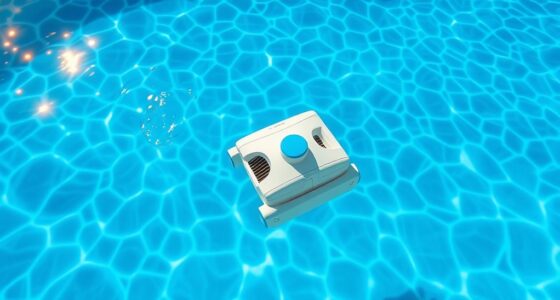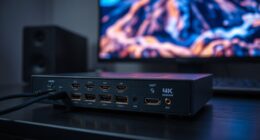Automatic pool cleaners are great at removing surface debris and dirt but can’t fully tackle algae or cloudy water caused by chemical imbalances. You need to maintain proper water chemistry, use shock treatments, and keep filters clean for clear, algae-free water. While these cleaners help, persistent issues often require chemical adjustments and professional help. If you want to discover how to effectively combine these methods, keep going to learn more.
Key Takeaways
- Automatic pool cleaners effectively remove surface debris but cannot address underlying water chemistry issues causing algae and cloudiness.
- They are limited in cleaning tight corners or hidden areas and cannot prevent algae growth without chemical treatment.
- Proper chemical balancing and filtration are essential for algae prevention and water clarity, complementing automatic cleaning.
- Regular filter maintenance and skimmer cleaning improve debris removal, but chemical treatments are necessary for persistent algae or cloudiness.
- Severe algae or cloudy water typically require manual chemical treatment and professional pool service beyond automatic cleaner capabilities.
How Automatic Pool Cleaners Work and Their Limitations
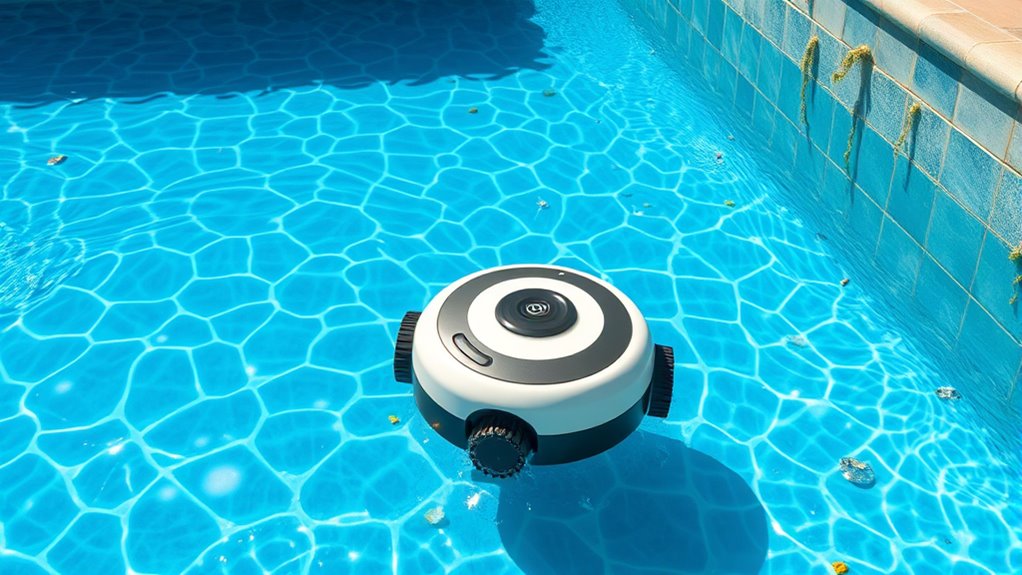
Automatic pool cleaners operate by moving around your pool’s surface or floor to remove debris efficiently, often using programmed patterns or sensors to navigate. They excel at picking up leaves, dirt, and other surface contaminants but aren’t designed to handle everything. Pool chemicals play a vital role in maintaining water clarity and preventing algae growth, which cleaners can’t fully control on their own. Pool covers help reduce debris entering the water, easing the cleaner’s job, but they don’t eliminate the need for regular cleaning or chemical balancing. Limitations include difficulty reaching tight corners or areas hidden by pool covers or fixtures. While these cleaners help maintain cleanliness, they should be used alongside proper chemical treatment and preventive measures for ideal pool health. Additionally, refrigerant leaks in heat pumps can lead to decreased efficiency, which emphasizes the importance of regular system maintenance to keep your pool clean and functioning properly. Proper pool maintenance routines, including chemical checks and equipment inspections, are essential to ensure your pool stays healthy and inviting. Regular maintenance also helps prevent issues like water imbalance which can lead to algae growth and cloudy water.
Effectiveness of Robotic Cleaners Against Algae Growth
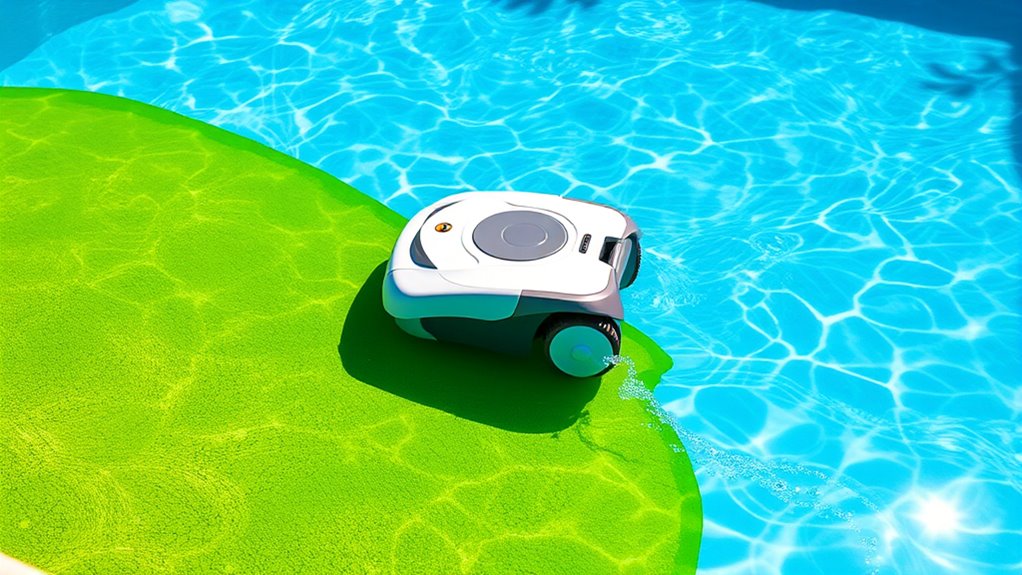
Robotic pool cleaners are effective at removing surface debris and dirt, but their ability to combat algae growth is more limited. While they keep the pool’s surface clean, they don’t address underlying issues like water chemistry or algae spores lurking beneath. Proper pool safety depends on maintaining balanced water chemistry, including pH and sanitizer levels, which robotic cleaners alone can’t achieve. Algae thrives in imbalanced water, so relying solely on robotic cleaners may lead to algae outbreaks if chemical levels aren’t monitored regularly. To improve algae control, you need to combine robotic cleaning with proper chemical treatment and filtration. This ensures your pool remains clear, safe, and healthy, rather than just superficially clean. Maintaining proper water chemistry is essential for preventing algae from thriving in your pool. Additionally, pool testing helps detect imbalances early and prevents algae from taking hold. Regular maintenance of filtration systems also plays a crucial role in preventing algae buildup and promoting overall water clarity.
Can Suction-Side Cleaners Tackle Cloudy Water?
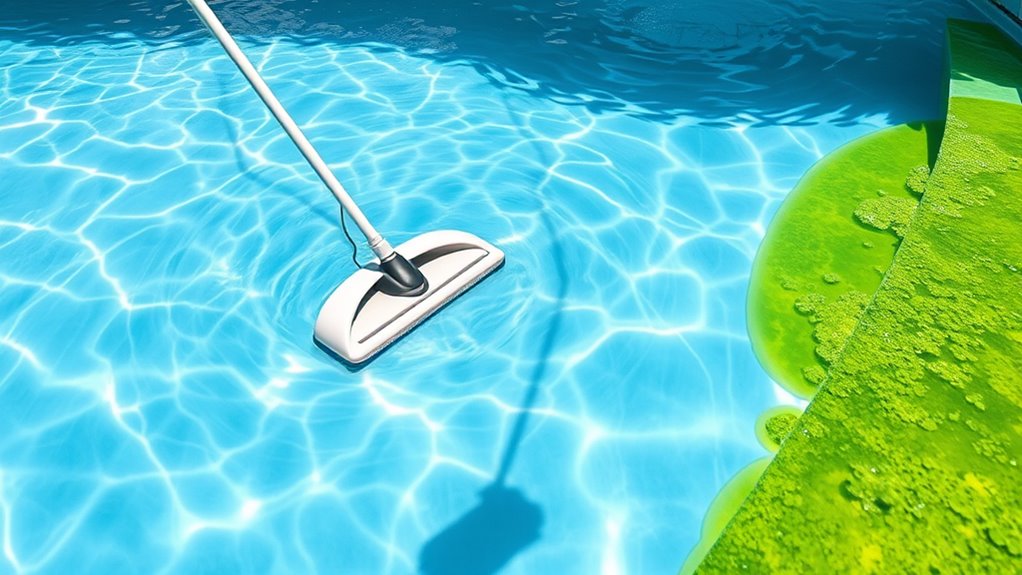
Can suction-side cleaners effectively clear cloudy water from your pool? The answer depends largely on your pool’s chemistry. Cloudy water often results from imbalanced chemicals, suspended particles, or inadequate filtration. Suction-side cleaners can help by removing debris, but they won’t fix underlying chemical issues. To improve clarity, focus on proper pool chemistry—shocking the water, balancing pH, and maintaining sanitizer levels. Equipment upgrades, like installing a more powerful pump or upgrading your filtration system, can also boost debris removal efficiency. Keep in mind, these cleaners work best with well-maintained pools. Regular cleaning of filters and skimmers complements their efforts, but addressing water chemistry is key to resolving persistent cloudiness. Proper pool maintenance and chemical balancing are essential for clear water. Suction-side cleaners are a helpful tool, but they’re just part of the solution. Additionally, understanding filtration efficiency can help you choose the right equipment to keep your pool clear. Improving filter performance through regular backwashing and component checks can further enhance clarity and debris removal effectiveness. Furthermore, incorporating vibrational energy techniques can assist in aligning your pool’s water quality with optimal vibrational states, promoting clearer water and healthier pool conditions. Moreover, selecting high-quality filtration systems designed for optimal debris capture can significantly improve overall pool water quality.
The Role of Filters and Skimmers in Managing Algae

Your filter’s efficiency and regular maintenance are key to keeping algae at bay, so check and clean them often. Proper skimmer placement and consistent use help remove surface debris before algae can take hold. Together, these tools work to keep your pool clean and algae-free with less effort. Regularly inspecting your self-watering planters ensures they function properly, preventing overgrowth of algae or debris in your pool’s filtration system.
Filter Efficiency and Maintenance
Ever wonder how filters and skimmers keep your pool crystal clear and algae-free? It’s all about filter efficiency and regular maintenance. Proper filter maintenance ensures debris filtration works effectively, preventing algae buildup. When filters clog, water circulation slows, making algae thrive. To keep your pool pristine, regularly clean or replace filter cartridges and backwash sand filters. Check skimmers daily to remove leaves and debris, which enhances debris filtration. Here are key tips:
- Clean filters frequently to maintain ideal flow.
- Remove debris from skimmers daily.
- Inspect for wear or damage during filter checks.
- Ensure skimmer baskets are free of obstructions.
Skimmer Placement and Use
Proper skimmer placement and use are essential for effectively managing algae and keeping your pool clean. Position your skimmer where water flow is strongest, typically near the main drain or return jets, to maximize debris removal. Correct skimmer use involves regularly cleaning the basket and ensuring the skimmer lid is secure, preventing debris from bypassing the filter. When your skimmer functions efficiently, it captures floating algae, leaves, and dirt before they settle and promote algae growth. This reduces strain on your automatic pool cleaner and improves overall filtration. Regular maintenance of the skimmer basket can also prevent blockages that hinder water flow and filtration efficiency. Proper maintenance of the filter system and its components can further enhance your pool maintenance routine. Monitoring water flow and ensuring proper circulation are crucial for consistent debris removal. Regularly inspecting and monitoring water flow can help identify issues early, ensuring your skimmer continues to perform optimally. Additionally, integrating algae prevention techniques can support your efforts in maintaining a pristine pool environment.
Identifying Signs That Your Pool Needs More Than Just a Cleaner
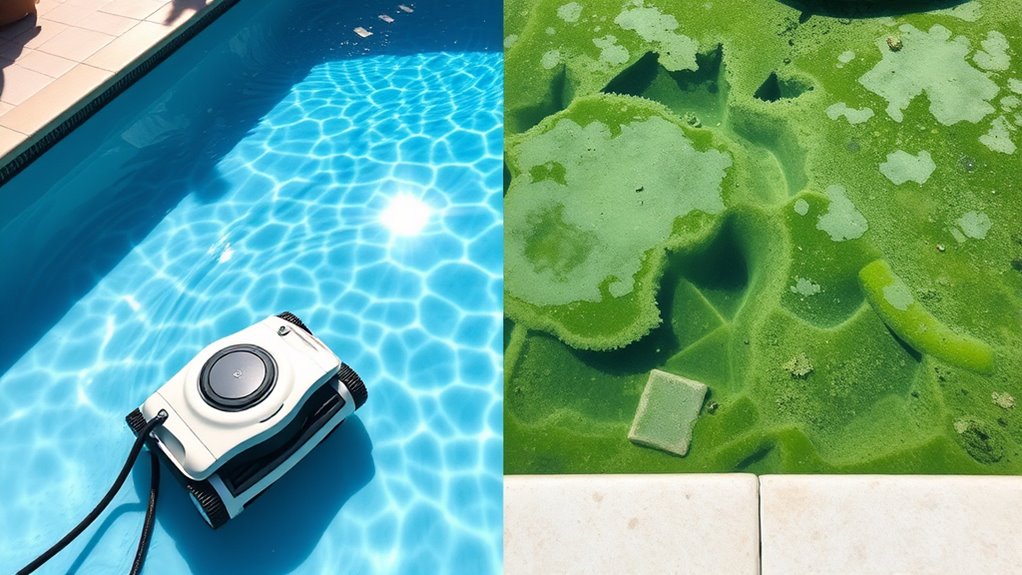
If your pool stays cloudy even after cleaning, it’s a sign something more is going on. Notice any unusual algae growth or if your current cleaner isn’t doing the job, it’s time to investigate further. These signs indicate your pool needs more than just regular maintenance.
Persistent Pool Cloudiness
Persistent cloudiness in your pool often indicates that more than just a cleaner is needed. If your water remains murky despite regular cleaning, it’s time to evaluate other factors. Poor water circulation prevents proper filtration, allowing debris and algae to build up. Proper water circulation is essential for effective filtration and preventing algae growth. Incorrect pool chemicals can also cause cloudiness, as imbalanced pH and sanitizer levels encourage algae growth and cloud formation. Signs include a dull appearance, a slimy surface, or lingering debris after cleaning. To troubleshoot, check your water circulation system, test and adjust pool chemicals, and ensure your filter is working effectively. Addressing these issues helps clarify your water and keeps your pool inviting and safe. Remember, sometimes a deeper chemical and circulation check is necessary beyond automatic cleaners. Additionally, water chemistry plays a crucial role in maintaining clear water and preventing algae growth. Understanding algae management is vital for long-term pool clarity and health.
Unusual Algae Growth
When you notice your pool developing a greenish tint or fuzzy patches on the surface, it’s a clear sign that algae is taking hold. Algae resistance can make it tough for your automatic cleaner to keep your pool spotless, especially when the algae starts to cling in hard-to-reach spots. If the water remains cloudy or green despite regular cleaning, it indicates that more aggressive treatment is needed. Algae can quickly compromise pool clarity, making it appear dull and uninviting. Spotting these signs early helps you address the problem before it spreads further. Relying solely on your automatic cleaner won’t be enough; you’ll need to manually treat the algae to restore your pool’s sparkle and maintain ideal clarity.
Ineffective Cleaning Results
Even after running your automatic pool cleaner regularly, you might notice the water still looks cloudy or the surface isn’t as spotless as it should be. This indicates your pool needs more than just a cleaner. Here are signs to watch for:
- Debris remains in corners or on the bottom despite cleaning.
- Water chemistry is off, with pH or chlorine levels fluctuating.
- Pool accessories like skimmers or brushes aren’t effectively removing algae or dirt.
- Filtration feels ineffective, and algae or cloudiness persist even after cleaning cycles.
These issues suggest your pool needs proper chemical balancing and improved filtration. Relying solely on an automatic cleaner isn’t enough if water chemistry isn’t maintained or if pool accessories aren’t functioning properly.
Features to Look for in an Automatic Cleaner for Algae Problems
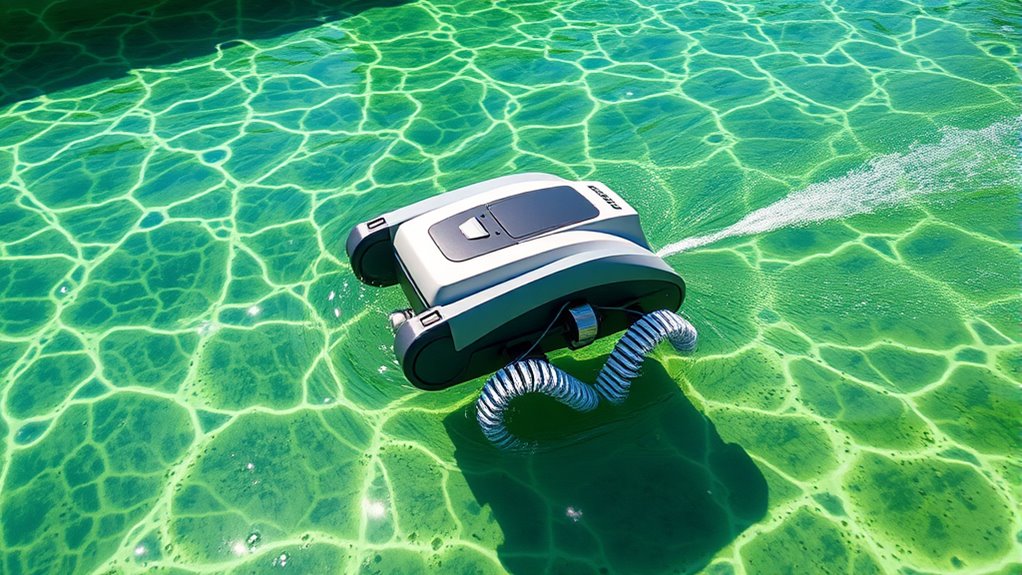
If your pool struggles with algae buildup, choosing an automatic cleaner with the right features can make all the difference. Look for models with strong scrubbing brushes that can tackle algae on surfaces and water features. A cleaner equipped with a high-efficiency filtration system helps trap tiny algae particles, preventing re-growth. Consider a unit with adjustable cleaning modes to target stubborn spots or areas with pool toys and water features where algae hide. Additionally, a longer runtime and easy navigation ensure thorough coverage, especially around complex shapes. Some cleaners come with smart sensors to detect dirty zones, optimizing cleaning paths. With these features, your automatic cleaner will be more effective at controlling algae, keeping your pool clear and inviting.
Combining Chemical Treatments With Mechanical Cleaning

Using chemical treatments alongside your automatic cleaner creates a powerful synergy that keeps your pool crystal clear. This combination enhances algae control and helps prevent cloudiness, saving you time and effort. By coordinating these methods, you can maintain a healthier, more inviting swimming environment.
Chemical and Mechanical Synergy
Combining chemical treatments with mechanical cleaning creates a powerful synergy that keeps your pool sparkling and healthy. Proper pool chemistry ensures chemicals are balanced, preventing algae growth, while mechanical design allows your cleaner to reach every nook. When used together, they maximize each other’s effectiveness. For example:
- Regular chemical adjustments make mechanical debris removal more efficient.
- Proper chemical levels reduce strain on your automatic cleaner.
- Mechanical cleaning removes physical debris, helping chemicals work better.
- Maintaining pool chemistry supports the longevity of your cleaner’s mechanical parts.
This integrated approach ensures your pool stays clear and algae-free, reducing the need for harsh chemicals and manual scrubbing. By coordinating chemical and mechanical efforts, you optimize your pool’s cleanliness and overall health.
Enhanced Algae Control
Have you ever wondered how to keep algae at bay more effectively? Combining chemical treatments with mechanical cleaning is your best strategy. Regular water testing helps you determine the right chemical levels, preventing algae growth. Using a pool heater can maintain consistent water temperature, which discourages algae proliferation. When algae begin to form, shock treatments combined with your automatic cleaner remove spores and debris efficiently. Maintaining proper chlorine levels and pH balance is essential, especially after chemical shocks. Your mechanical cleaner handles surface algae and debris, while chemicals target microscopic spores. This synergy ensures algae don’t get a foothold, keeping your pool clear and inviting. Consistent water testing and adjusting chemical levels, alongside mechanical cleaning, provide a thorough approach for enhanced algae control.
Preventing Cloudiness
Preventing cloudiness in your pool requires a proactive approach that balances chemical treatments with mechanical cleaning. Proper chemical management guarantees ideal pool chemistry, preventing algae and bacteria growth that cause cloudiness. Mechanical cleaning, such as automatic pool cleaners, supports biological filtration by removing debris and particles that can clog filters. Combining these methods keeps water clear, healthy, and inviting.
Here are four key steps:
- Regularly test and balance pool chemistry to maintain pH and sanitizer levels.
- Use algaecides and clarifiers to enhance chemical effectiveness.
- Run your automatic cleaner frequently to remove debris and prevent buildup.
- Backwash or clean filters routinely to support biological filtration and ensure efficient water flow.
This integrated approach keeps your pool crystal clear and minimizes cloudiness.
Common Mistakes That Reduce Cleaner Performance on Algae and Cloudiness

When your automatic pool cleaner struggles to remove algae and cloudiness, it’s often due to common mistakes that hinder its effectiveness. One key error is neglecting proper pool chemistry; if pH, chlorine levels, or alkalinity are off, algae and debris become harder to clear. Additionally, poor equipment maintenance, such as dirty filters or clogged intakes, reduces the cleaner’s performance. Failing to regularly clean or replace filters can cause blockages and decrease suction power. Overlooking these aspects allows algae to cling to surfaces and cloud water instead of being removed efficiently. Ensuring balanced pool chemistry and routine maintenance keeps your cleaner operating at peak performance, reducing algae buildup and improving water clarity. Avoid these mistakes for a cleaner, healthier pool.
Best Practices for Using Automatic Cleaners in Problematic Pools
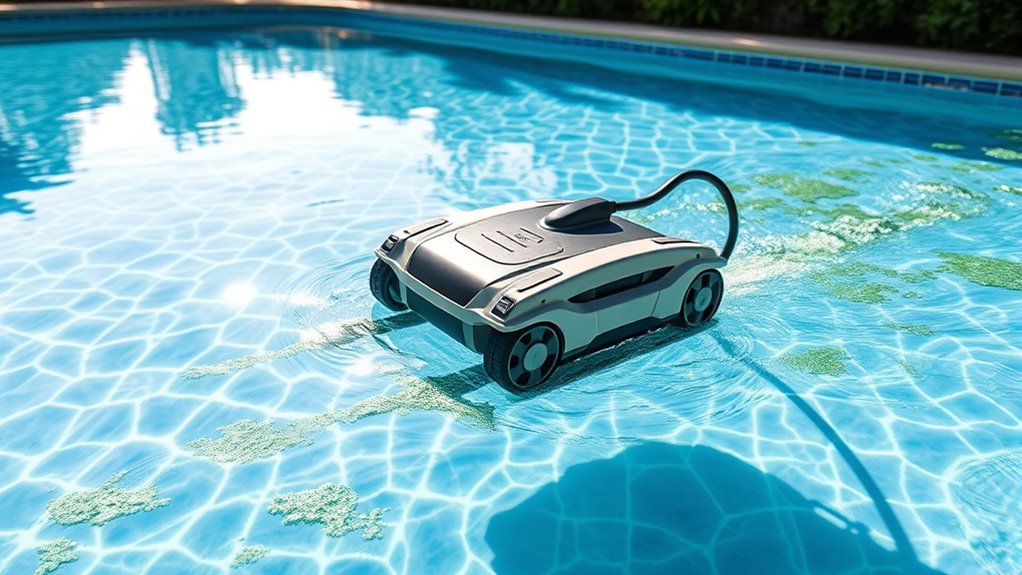
Dealing with problematic pools requires more than just running your automatic cleaner; it involves adopting specific best practices to maximize its effectiveness. First, confirm your water chemistry is balanced—test regularly and adjust chemicals to prevent algae growth. Second, clean your pool deck and surrounding areas to reduce debris that can clog the cleaner or spread contaminants. Third, pre-shock the pool if algae or cloudiness is severe, giving the cleaner a head start. Finally, run the cleaner during off-peak hours to minimize interruptions and optimize coverage. Consistently maintaining water chemistry and keeping the pool deck clear helps your automatic cleaner work more efficiently, ensuring a cleaner, healthier pool even in problematic conditions.
When to Consider Professional Pool Treatment Over Automatic Cleaning

While automatic pool cleaners are effective for routine maintenance, there are times when professional treatment becomes necessary to address persistent or severe issues. If you notice ongoing algae growth, persistent cloudiness, or unbalanced pool chemistry, DIY cleaning may not suffice. Poor pool chemistry can harm equipment longevity and compromise water quality, making expert intervention essential. Additionally, if your automatic cleaner struggles to remove stubborn debris or if equipment parts frequently break down, a professional treatment can restore proper function and protect your investment. When issues exceed basic cleaning capabilities, professional pool service ensures thorough chemical balancing, equipment inspection, and repairs. Recognizing these signs helps maintain your pool’s health, safety, and longevity, preventing costly repairs down the line.
Frequently Asked Questions
Can Automatic Pool Cleaners Prevent Future Algae Growth?
Automatic pool cleaners are great for algae prevention, but they alone can’t fully prevent future growth. To keep algae at bay, you need regular filtration maintenance, ensuring your system runs efficiently and removes debris that promotes algae buildup. Use proper chemical balance and run your cleaner frequently. Combined, these steps help maintain clear, healthy water and reduce algae risks, making your pool a more inviting space.
How Often Should I Run My Cleaner in Algae-Prone Pools?
You should run your automatic pool cleaner daily in algae-prone pools to keep debris and algae spores in check. Maintaining proper pool chemistry is essential, so regularly test and adjust chemicals. Manual brushing of pool walls and floor helps loosen algae, making your cleaner’s job easier. Consistent cleaning and good chemical balance prevent algae buildup, ensuring your pool stays clear and safe.
Do Robotic Cleaners Remove Algae Spores From Pool Surfaces?
Robotic cleaners can remove algae spores from your pool surfaces, but they don’t eliminate surface contamination alone. You need to treat algae spores, prevent their spread, and target the algae itself. While robotic cleaners scrub surfaces and reduce debris, battling algae requires proper chemical balance and filtration. Think of your pool’s health as a team effort—robotic cleaners are valuable players, but you must also manage chemicals and filtration to keep algae at bay.
Are Automatic Cleaners Effective in Deep or Large Pools With Algae?
For large or deep pools, automatic cleaners can be effective, but you’ll need to evaluate your pool size and cleaning frequency. Larger pools require more frequent runs to prevent algae buildup, and some cleaners may struggle with extensive algae. Regular maintenance and choosing a robust model ensure better results. Keep in mind, automatic cleaners work best with combined efforts like chemical treatments to keep algae at bay.
Can Automatic Cleaners Handle Algae in Saltwater Pools?
Automatic pool cleaners can assist with algae removal in saltwater pools, but they aren’t entirely effective on their own. While many models are saltwater compatible, algae can be stubborn and may require manual scrubbing or chemical treatment. Using an automatic cleaner helps keep your pool surface clean, but for thorough algae control, you should combine it with proper chemical balance and regular maintenance.
Conclusion
Think of your pool as a garden: automatic cleaners are like diligent gardeners, but sometimes you need to bring in the expert to truly weed out stubborn algae and cloudy waters. While these cleaners handle routine debris, they can’t do all the heavy lifting alone. Combining their effort with chemical treatments and professional care guarantees your pool stays crystal clear and inviting. With the right balance, you’ll enjoy a sparkling oasis without getting caught in the weeds.





